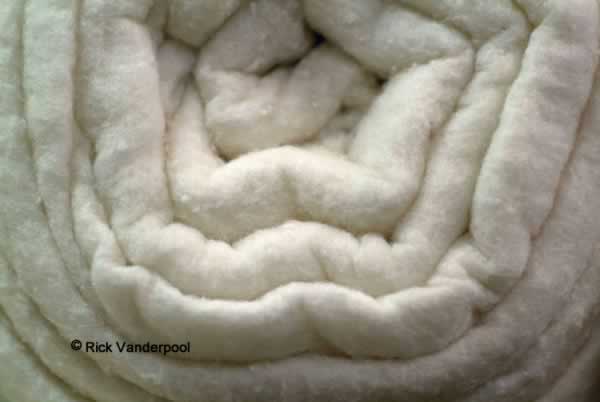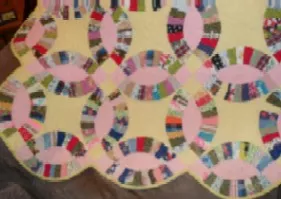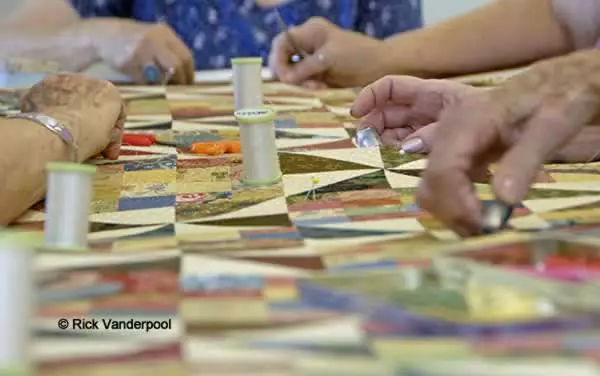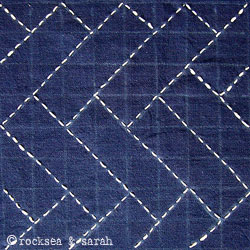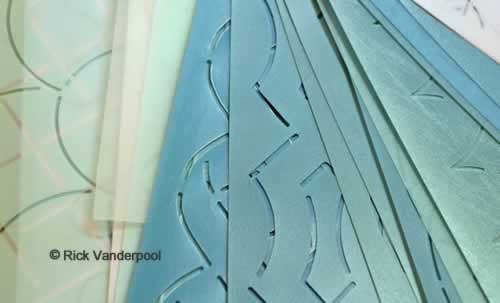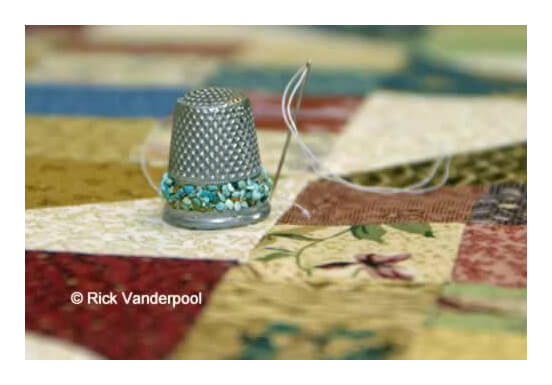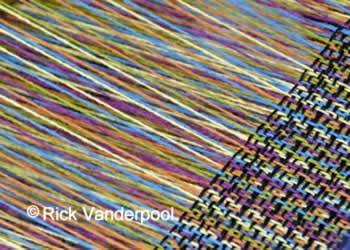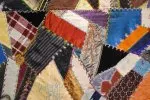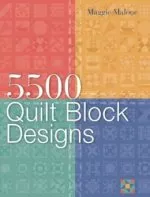Quilt Glossary
This post may contain affiliate links. Read the full disclosure policy here.
Quilting, as with any profession or passion, has its own vocabulary. This quilt glossary is a listing of terms, definitions, and jargon. If there is terminology or words that should be included or corrections needed, please send a note to us using the Contact Us page.
Terms and Definitions
A
Allover design: a pattern that covers the entire quilt from edge to edge with regular small units and does not have a border.
All white quilt: also called Whole Cloth.
|
Amish quilt: quilts made by Amish women that reflect the group's commitment to their Christian faith and the values of simplicity and humility. |
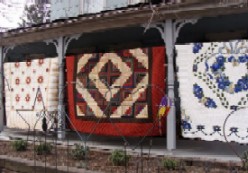 Amish quilts on a porch Amish quilts on a porch |
|
Appliqué: technique of attaching a piece of fabric onto a larger piece of contrasting fabric. To prevent fraying, the edges of the fabric may be turned under and sewn or sewn down with a blanket or satin stitch. |
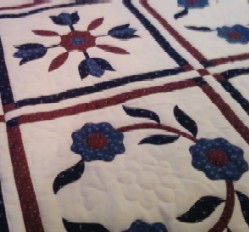 |
B
|
Baby quilt: small quilt made to fit easily in a crib or stroller, usually with fabrics and designs appropriate for babies. Good starter quilts for beginning quilters. |
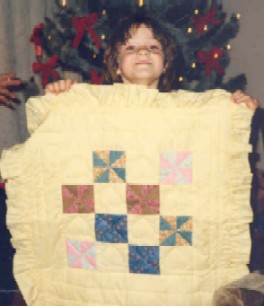 |
Backing: a piece of cloth forming the underside of a quilt. May be several pieces seamed together.
Batiste: any fabric constructed in a sheer, fine, plain-weave. Named for Jean Baptiste, a French linen weaver, batiste is widely used in Amish quilts.
Batting: the inner layer between the top and back; adds insulation and warmth. Usually cotton, wool, or polyester; gives the quilt its fluffiness (loft) and warmth. Newer types of batting are made from silk, cotton/polyester blends, soy fibers, and bamboo. Each type of batting material has different characteristics, giving dimension to the quilted surface.
Bearding: when batting fibers migrate up through the quilt top; special finishes put on the batting during manufacturing help reduce bearding. Using dark batting in a dark-colored quilt reduces the visibility of the fibers.
Bee : see Quilting Bee.
Bell thread: commercial brand of thread sometimes used to tack, or tie, quilts.
Bias: the diagonal direction on a piece of woven cloth. Fabric stretches more along the bias than in the directions parallel to the woven threads.
Binding: one of several different techniques for encasing the raw edges of a quilt. (1) a narrow edge of backing turned over on the top and hemmed down; (2) the edges of the back and top are turned in and run together; (3) a separate strip of fabric, picking up one of the colors of the tops or in a contrasting color, is stitched around the quilt. Binding also refers to the separate strip of fabric used to bind the edges of a quilt.
Blind hemming: see Hemming
Block: a basic unit of quilt construction; usually in the form of a square of pieced or appliquéd patchwork that is put together with other blocks to make a quilt. A block may be any size from very small to big enough to cover a bed.
Border: length of fabric that frames the outside edge of the quilt top. Can be as simple as solid strips or as complex as intricate geometric patterns or appliqués.
Bridal Quilt: see Marriage Quilt
C
Calico: a general term for plain-weave cottons that are typically light-weight, low-count material that are usually sized or finished for crispness. Usually thought of as a printed material, calico was one of the staple goods of the 1800s pioneer woman.
Calendering: process of passing cloth under high heat or pressure to produce a surface texture.
Cashmere: true cashmere is a fabric woven from the hair fiber of cashmere goats mixed with other fine wools. Cashmere is a fine and costly twill-weave material with a soft finish.
Chambray: durable cotton fabric in plain weave with a smooth and lustrous finish. It is woven with colored warp yarns and white fillings. Chambray is a form of gingham.
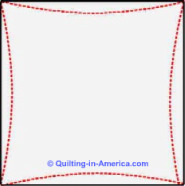
Continuous curve quilting: starting in the intersection of seams on a quilt top the quilter creates arches that extend about 1/4" away from the seam at its midpoint, and then down to the next intersection. This design creates some movement and interest as well as making piecing mistakes less prominent. See also -- Outline Quilting; Stitch in the Ditch
Cornerstone: small contrasting square at the corners of the sashing around each block.
|
Cotton: most widely used fabric in the world. It is the cheapest and most available natural fiber. Cotton is durable, easily cleaned, dyes well, and can be woven into a diverse number of products. |
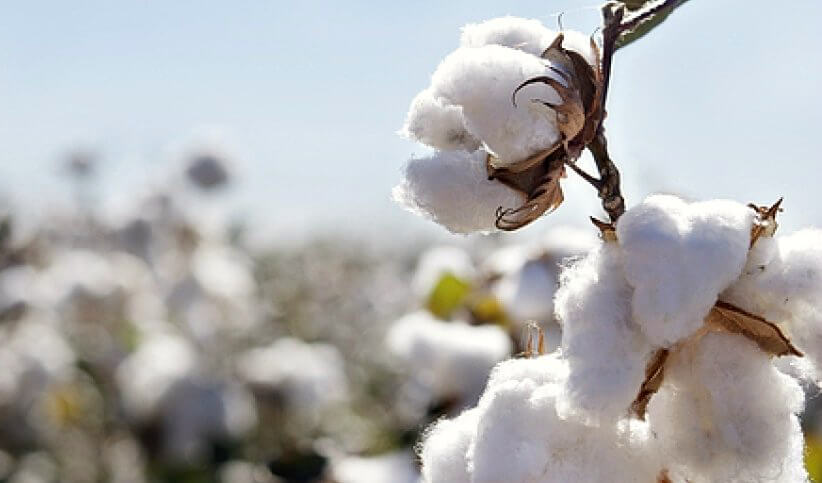 Cotton in the field Cotton in the field |
Crazy quilt: unique type of patchwork that reached the height of its popularity in the Victorian era (late 1800s). Irregularly shaped scraps of silks and velvets are pieced together, then lavishly embroidered. The term "crazy" is defined as full of cracks or flaws, as having the appearance of crazed pottery, broken into irregular segments. These quilts only seem to be the work of lunatics.
Cornerstone blocks: contrasting squares the width of lattice strips (sashing) set where the strips intersect.
Counterpane: general term for a bedspread, that is, a textile intended to serve as the visible top layer when a bed is made up with several layers of bedcovers.
Countypin: variant term for counterpane.
D
Darning foot: sewing machine foot, usually round or oval and/or clear plastic, used with the feed dogs lowered for free-motion quilting.
Double Wedding Ring: Traditional block pattern with a motif of two or more interlocking rings. The rings are typically made up of small scraps of fabric cut into arced pieces sewn together to form interlocking rings or circles. These exquisite quilts were frequently made for children or grandchildren as wedding gifts. Because this pattern is fairly difficult, less proficient quilters sometimes use cheater fabrics which have the pattern printed on them so no actual piecing is necessary, only the quilting.
E
Edge-to-Edge quilting: See also -- Overall Quilting.
English Paper Piecing: See also -- Paper Piecing.
F
Feathering: a method of decoration in which a shape is outlined with small half-square triangles. This Sawtooth pattern was a common way to embellish plain shapes.
Feed Sacks: Until the mid-1900s, flour, sugar, salt, tobacco, and animal feed were sold in cloth sacks. Thrifty seamstresses would take the sacks apart and use the fabric for quilts and clothing.
Finishing: describes any number of chemical and physical techniques used on the finished woven material to enhance or change its appearance. Typical finishes include bleaching, napping, calendering, sizing with starch or gum, and mercerizing.
Flannel: a loosely woven cloth of either plain- or twill-weave that is characterized by its softness and warmth.
Flax: made from the flax plant, it is one of the oldest textile fabrics. Flax was a major fiber source until the early 1800s and was used to make linen.
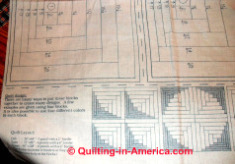
Foundation piecing: assembling a block by sewing pieces to a foundation of muslin fabric that was cut to the desired size of a block or an entire bed. This method was used as the the underlying structure for building "pressed quilts," crazy quilts, and applique. In the late 1900s, new techniques with foundation materials were developed, including printed foundation fabrics -- particularly useful for Log Cabin or Pineapple blocks. Printed paper foundation, such as Triangles-on-a-Roll or Thangles, is a variation of this technique, and is useful for sewing half-square and quarter-square triangles. Since paper is removed after completion, it does not add strength. See also -- Paper Piecing.
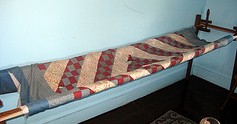
Frame: a device, usually made of lengths of wood or metal, for holding the layers of a quilt taut so that they can be hand-quilted together smoothly, without folds or puckers. In a full frame, the entire quilt is stretched out at the beginning and the side rails are rolled up in the quilt as portions are quilted. Other frames are designed to maintain a constant distance between the side rails, so that the quilt must be rolled and unrolled like a scroll until the quilting is completed.
Free-motion quilting: machine-quilting -- with feed dogs lowered, quilter slides quilt top under the moving needle of a sewing machine, stitching it in any direction; stitching may be simple wavy lines or very complex patterns.
French knot: an embroidery stitch formed by wrapping yarn around a needle as it is drawn through the cloth.
Fussy Cut: cutting a portion of a printed fabric so a particular portion of it fits within the size or boundaries of the block.
G
Gingham: plain-weave cotton material that is traditionally checkered, but may also be a solid color. Chambray is a form of gingham.
Grain: the directions in which the warp and weft threads lie in a woven fabric; warp threads run parallel to the selvage and perpendicular to the weft threads.
H
|
Hand quilting: putting the quilt stitching in a quilt by hand rather than with a sewing machine; favored method of quilting until the late 1900s. See also -- Machine quilting. |
Hanging sleeve: 4-inch tube of fabric sewn to the top of the back of a quilt to allow easy hanging from dowels for display.
Hemming: the process by which an edge is turned under and sewn down with small stitches. Regular hemming is made with small slanting stitches which show on the right side. Blind hemming is done like regular hemming, but with larger stitches through the fold, and only one thread shows on the right side, thus making it nearly invisible. Hemming is used to attach binding to a quilt after it's been turned under.
I
Italian quilting: also called Trapunto.
J
Jean: cotton, cotton and wool, or cotton and linen twilled cloth.
L
Lap quilt: small quilt typically put together with 6 to 9 blocks (approx 40”x60”). Good to drape over a chair or sofa. Good size for beginners.
Lattice strips: Strips of fabric, usually from 2 to 4 inches in width, that frame each block in a quilt. To avoid a rigid grid that would dominate the pattern, corners the width of the strip, but of a different color, are set where the lattice strips intersect each other. See also -- Sashing.
Linen: a wide variety of fabrics of different grades and weaves made from fibers of the flax plant. Linen was a major fabric for household textiles until it was replaced by cotton.
Linsey-Woolsey: a coarse, strong, durable fabric made of flax fibers. Flax was one of the larger crops in colonial America and linsey-woolsey was typically a home-woven fabric. It was one of the earliest fabrics used in American quilts. It consisted of a linen, or sometimes cotton, warp (lengthwise threads)and a wool weft (crosswise threads). The name Linsey came from a village in Saussex, England.
Loft: thickness or puffiness of quilt batting; varies from very thin (1/4") to very puffy (1" or more)
M
Machine quilting: sewing the quilting stitches with a sewing machine rather than by hand. Even though the sewing machine became widely used in the mid-1800s, hand-quilting remained prevalent until the late 1900s. The first major award for a machine-quilted quilt was for Caryl Bryer Fallert's Corona II, the Solar Eclipse which won Best of Show at the American Quilter's Society quilt show in 1989.
Madder Red: Popular in the late 19th century, this bright red dye made from the roots of the rubia plant (also known as the madder plant), was less colorfast than the highly-prized Turkey Red dye. While both dyes were made from the madder plant, the Madder Red process used water, while oil was used to make Turkey Red, resulting in a dye that often bled onto adjacent fabrics or faded to a reddish-brown. Madder Orange and Madder Brown could be produced by modifying the ingredients added to the process and varying the intensity of the dye.
Marking: the process of putting the quilt design on the quilt. Historically, this was done by drawing with pencil or chalk, either freehand or tracing wood or tin templates or household objects, such as plates, cups, or spoons. Since then, imaginative techniques and materials have been developed to include pre-printed paper designs that are adhered to the quilt and removed after the quilting is complete, punched stencils that are set on the quilt and a special powder sprinkled on, and pens and pencils that make marks that either wash out easily or simply disappear over time.
Marking tools: colored pencils, water soluble markers, chalk, markers with ink that disappears after a short time or when heat is applied, to mark the stitching lines on a quilt; also may be used to mark lines for piecing.
Marriage quilt: In the 1700s an engaged girl would invite her friends to a quilting get-together. They would help her quilt her Wedding Quilt -- the last of her 13 requisite baker's dozen of quilts, and the only one that could contain hearts and other symbols of love. A common superstition was that it was bad luck for an engaged girl to work on her own Wedding Quilt. It came to be the custom that the friends also each brought a block to the party to be put together and quilted and presented as a wedding gift. The custom was popular until around 1900. Also known as Bridal or Wedding quilt.
Masterpiece quilt: a quilt that displays the epitome of the quilt-maker's designing, sewing, and quilting skills. The careful piecing of diamonds in The Lone Star and The Star of Bethlehem are often considered the height of skill for quilters, as are the intricate Horn of Plenty applique quilts.
Meandering: a quilting design that wanders across a quilt's surface with no apparent plan; stitching may have puzzle piece shapes (larger than stippling), or it can be stars, swirls, loops, flowers, or any design of the quilter's choosing.
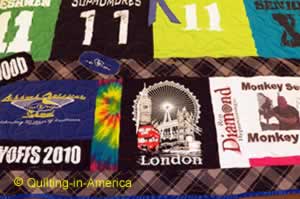
Memory quilt: quilt made with special memorabilia, such as photographs (transferred to fabric), t-shirts, scraps of materials that were meaningful to the recipient; memory quilts are frequently made to commemorate events such as anniversaries and graduations.
Medallion quilt: a quilt made by choosing a central motif and building out from it in concentric framing strips that may be fancy pieced work, applique, or plain cloth. This quilt type was particularly popular from about 1700 to 1830.
Mercerizing: a finishing technique, invented by John Mercer in 1850, whereby cotton yarn fibers are impregnated with cold, concentrated sodium hydroxide solution resulting in increased luster, stretch and dyeabilty of the yarns.
Muslin: variety of plain-weave cotton fabrics used extensively in quiltmaking throughout the 1900s.
N
Natural fibers: four major natural fibers are wool, cotton, silk, and linen.
O
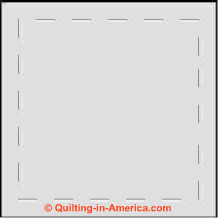
Outline quilting: quilting design in which stitching lines are 1/4" away from seam lines. See also -- Continuous Curve Quilting; Stitch in the Ditch
Overall quilting: quilt stitches that cover the quilt's surface completely, without regard to borders, blocks, or other natural boundaries; the stitching is typically done freehand. See also -- Edge-to-Edge Quilting.
P
Paper Piecing: method of hand piecing where paper templates are used inside the block elements to guide where the edges are turned under and templates are removed. Baby Blocks, Grandmother's Flower Garden and other non-square shapes, particularly those with narrow, sharp corners, are often pieced this way.

Patchwork: pattern shapes developed from leftover scraps sewn together.
Piecing: the making of the quilt top by sewing smaller pieces of fabric together.
Plain Weave: the simplest and least expensive method for constructing fabric. To create the weave, the filling is simply passed over one warp thread and under the next across the length of the fabric. Each row alternates this under-and-over pattern, resulting in a cloth that looks like a simple grid.
Pressed quilt: a method of joining fabric pieces in a quilt. A piece is first sewn on a foundation block with a running stitch. The second piece and all subsequent pieces are placed face down, right sides together on the preceding piece. A seam is made through both pieces and the foundation block. The piece is then "pressed" open and is ready for another piece to be added. Log Cabin, Pineapple, and Grandmother's Fan are all examples of pressed quilts.
Puzzle quilt: a sampler quilt in which each block design is used twice, in different colors and fabrics; the puzzle is to pick out which blocks are the same.
Q
Quilt: a textile sandwich consisting of 2 pieces of fabric with a filling between them. The upper layer, or top, is decorative. The bottom, or backing, is usually, but not always, rather plain. The filling, or batting, provides the warmth and loft (thickness).

Quilting: 1) sometimes refers to the entire process of making a quilt; 2) the actual sewing together of the layers of a quilt: top, batting, and backing; or 3) the term used for the stitches, usually decorative, that hold the 3 layers together, keep the batting from shifting, and helps trap the air necessary to act as insulator.
Quiltmaking: the entire process of making a quilt: both piecing and quilting
Quilting Bee: Members of rural communities frequently joined together to help their neighbors with big projects, such as barn building or finishing quilts. The quilting bee was a social event involving friends and neighbors gathered to help a woman work on her ongoing projects that allowed the finishing of several quilts in a single day instead of weeks or months.
R
Reverse applique: a method of applique in which 2 or more layers of fabric are sewn together. The top layers are cut through revealing the underneath layers. The cut edges are turned under and hemmed or stitched with a satin or blanket stitch. South and Central American molas are made in this technique.
Rooster tail: a knot showing on the quilt
Rotary cutter: A very sharp tool that looks like a pizza wheel that is capable of cutting through multiple layers of fabric.
Running stitch: a simple stitch used for quilting, basting, and piecing in which the needle goes in and out of the cloth usually picking up 2 or more stitches at a time.
S
Sashiko: a popular modern quilting running-stitch technique that originated with ancient Japanese peasants who stitched and patched their clothes. Later, during the 18th and 19th centuries, sashiko became less utilitarian and more artistic. Traditionally done by hand, sashiko may be mimicked with a sewing or quilting machine. Purists who want to create the distinctive and celebrated stitch with a machine can with the Babylock Sashiko machine with its unique needle system and adjustable stitches and spacing.
Sashing: See also -- Lattice Strips.
Sateen: a variation of the satin weave, also called filling-face satin weave, in which the front of the fabric shows more filling than warps, thus creating a sheen across the surface of the material.
Satin Weave: based on the principles of twill, satin weave is identified as a separate technique because of the appearance of the finished material: the front side exhibits more warp than filling threads.
Scrap/Scrappy quilt: quilt made from dressmaking or other scraps. A scrappy quilt top utilizes a great variety of fabrics, each block often being pieced from a different combination of materials. It is therefore not necessary to have a large quantity of one fabric on hand to piece these tops. Scrap quilts are often quite striking and unique because the need for making do forces the quilter to focus on elements in the design such as light/dark shading, color play, and scale.
Serge: twill-weave fabric with a prominent diagonal line visible on both the front and back.
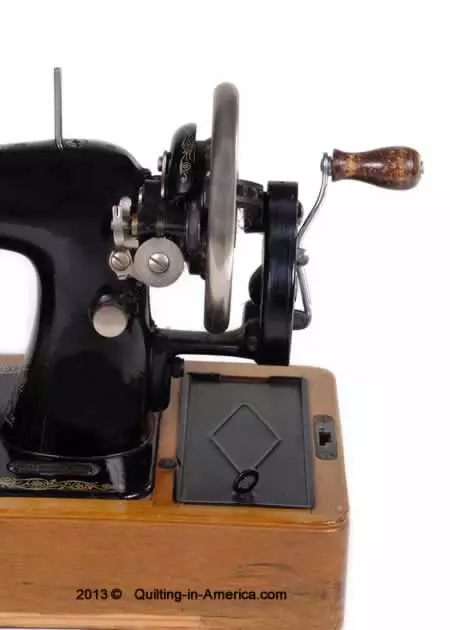
Sewing Machine: patented in 1846, the sewing machine allowed quilters to piece their fabric much more quickly. Quilters continued to hand-quilt the layers; machine quilting of the layers did not become popular or widely accepted until a century later.
Stash: a quilter's fabric collection; often organized by color.
Stippling: very close, tiny quilting stitching lines forming shapes resembling small puzzle pieces; typically stippling lines do not cross each other.
Stitch in the ditch: nearly invisible quilting stitches that follow the seams of the pieced top, in the tiny gap of the seams. See also -- Continuous Curve Quilting; Outline Quilting.
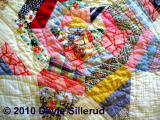
String patchwork: a utility needlework technique in which long, narrow sewing remnants are sewn to a paper or cloth foundation. String patchwork is similar to crazy patchwork, except that the strings are generally longer and narrower than pieces in a crazy quilt.
Strip piecing: a construction technique in which long, narrow pieces of fabric are joined lengthwise, sometimes with long rows of quilt blocks, to form a quilt top. The term strip is also used to describe the long pieces of fabric between blocks (see Sashing) or to describe the small, narrow remnants used in string patchwork.
Synthetic fibers: man-made fibers that are chemically produced. Among the most widely used synthetic fibers are rayon, nylon, polyester, and acrylics.
T
Tacking: See also -- Tied Quilt.
Template: a precisely measured, reusable model, often of cardboard or plastic, which is used to size the individual pieces of fabric when they are cut for patchwork or to mark designs for quilting on a finished quilt top.
|
Thimble: a small, dimpled cap, usually of metal, designed to fit over the end of the finger to protect it from injury as it repeatedly pushes a needle through cloth during sewing or quilting. |
Tied quilt: simplest form of quilting in which the layers are joined together by means of yarn or thread pulled through at regular intervals and then knotted. The tufts of yarn are frequently left as decoration. Tying is used when time is at a premium or when no filling is used so elaborate quilting is not necessary. Thick high-loft bedcovers are often tied instead of quilted because easy passage of a needle through the layers is impossible.
Toenail hanger: an overly long quilting stitch
Top: the uppermost layer, or front, of a quilt, which is usually the decorative side.
Trapunto: a way of making high-relief quilting designs favored by Kentucky mountain women. Through 2 or more layers, a design is outlined with a double row of running stitches. Rug yarn is drawn through the double lines of stitches, throwing the design into strong relief.
Turkey Red: Made using the root of the rubia plant (also known as the madder plant), this highly colorfast dye was manufactured through a long and laborious process. It originated in India or Turkey, thus its name, and was brought to Europe in the 1740s, and was used to dye cotton in the 18th and 19th centuries. Highly prized, it is differentiated from Madder Red, by its superior dye-making process which used oil instead of water.
Twill Weave: considered to be the most durable weave. The filling is interlaced with the warps in such a way as to form diagonal ridges across the fabric. Twills include broadcloth, cashmere, covert cloth, denim, drill, gabardine, jean, and serge.
U
UFO: in quilting, the abbreviation for the term UnFinished Objects, used to describe unfinished quilt projects
W
|
Walking foot: sewing machine foot that feeds fabric from the top while the feed dogs feed the fabric from the bottom, preventing shifting, tucks, and puckers; particularly useful in quilting when stitching in the ditch. |
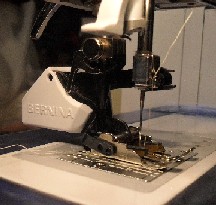 |
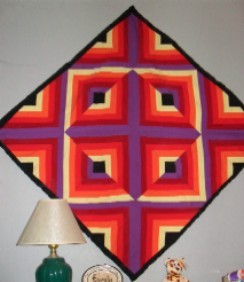 |
Wall hanging: a quilt, usually smaller in size than a bed quilt, designed to be displayed by hanging vertically as a decorative element. |
Warp: during weaving, the threads that run across the length of the fabric.
|
Weave: the way a fabric is constructed (a mechanical process in which warp and weft threads are interlocked). There are 3 basic weave patterns: plain, twill, and satin. |
Wedding Quilt: see Marriage Quilt
Weft: during weaving, the filling threads that cross the warp and run across the width of the fabric.
|
Whole cloth: a quilt in which the top is a single piece of cloth (or lengths joined together), rather than being made of patchwork. Traditionally, the top was solid white fabric on which elaborate quilting was the sole decoration, but many beautiful whole cloth quilts were made on printed fabric or decorated in some |
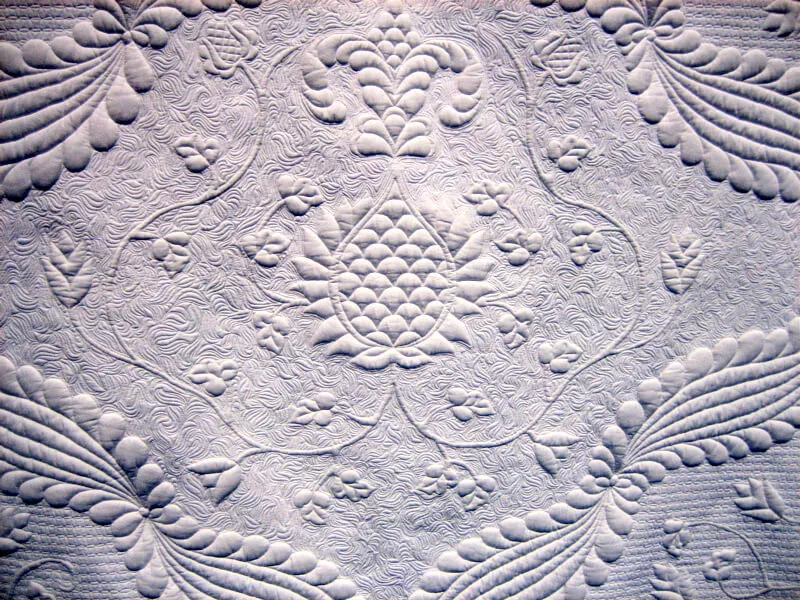 |
way, such as embroidery or applique. The design was emphasized and given higher relief by inserting extra padding through small slits made in the back after the design was quilted. This style of quilt was made in America by the higher social class in the late 1700s and early 1800s.
WOF: abbreviation for the phrase Width of Fabric used to describe the cutting of strips of fabric for piecing
Wool: natural fiber made from the hair shorn from sheep and other animals that is generally regarded for its softness, warmth, and resiliency. Wool is more sensitive to soap and water, and prone to moth infestation, so requires more care in its maintenance and laundering than other fibers.
Y
Yo-yo: a novelty technique in which circles of fabric are gathered into flat pouches and sewn together to make bedspreads or other items. The yo-yo technique has roots in 19th-century handwork, but became very popular in the 20th century.
